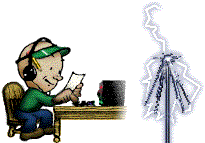
Web Site of Amateur Radio Station:
ex: N1GSW, WA6YMC, WA2TKE, WV2TKE
A.R.S. NZ1Q - Ed
St Petersburg, FL, U.S.A.
 The Radio Station
The Radio Station 
My fascination with Radio
I received my first amateur radio license in 1961 when I was 13 years
old. To become licensed I learned Morse code and the rules and regulations
of radio operation. I met many friends, nearby and far away. It has
been lots of fun over the years. One of my favorite things to do is to
meet and talk with people in foreign countries.
I got started many years ago when my Dad helped
me build a crystal radio, winding our own coils and stringing up a wire
antenna. After that I was helped by John. John was an older gentleman who had been
a ham radio operator for a long time. His call was originally
"2ADC". The 30th ham to be
licensed in the NY/NJ call area. His call later became W2ADC. John gave me my
first license exam for the novice class license and sold me a home made
(homebrew) transmitter, he is my first contact and gave me my first QSL card. Within a year, I studied for and passed the test
for the General class license. From there I built several transmitters and
amplifiers as well as many wire and vertical antennas. It's been fun from that point
on.
For more information on amateur radio try: ARRL

My quest is to talk to and exchange cards with other Hams in every country of
the world.
NZ1Q as Web Master ;-)
Web Master ;-)
Where it started for me - NYC, 1961... How I got into radio
As a 2-lander (the call area where I lived as a kid), the long trip into NYC to take the
amateur radio license exam at the Fed Building on Washington Street was a tense time - not knowing what was
in store. Of note was the WWII vintage earphones for listening to Morse
code (required for the exam - had to write it down without mistakes), in a room with maybe 20 or so
code copying stations on long tables, as I recall. Yes, and old straight keys for
sending (also part of the test). I never felt comfortable with those blocks of 5 random letters and numbers, but passed it anyway after lots of prep hours with W1AW code
practice sessions (thanks W1AW).
The FCC guy (was there more than one?) was like a stereotypical private school teacher - very reserved and
would almost seem disappointed if you screwed up. The building interior consisted of a maze of
various partitions (cubicles, we'd call them now, I suppose) painted in government-issue green. You took the code test first; that determined if
you'd be allowed to go on to the written examination. The earphones at each listening station behind the glass-walled testing room were collector's
items even then. Each desk had a J-38 type hand key because once you got past the copying test (straight copy for at least 60 seconds based on number
of correct letters on the sheet--you had to write it all down if you expected to pass), you had to prove to Charlie and his cigar that you could
send readable Morse with a hand key--no mean feat with smoke swirling around your face as he puffed and watched you sweat, trying to send (see?) what was
on the laminated sample text he had given you. Then, you got the written test.
In those days, the General was as far as anyone needed to go. The written test was 40 or 50 questions, and you had to
draw a few schematics from scratch. Once you passed your exam, you had to go back out on the street with your
application to get your signature notarized I believe I found the required notary at a Bail Bond shop across from the Fed building. What an experience for a 13 year old.
And the novice ticket, WV2TKE, given to me by a general & my Elmer. W2ADC (first licensed as 2ADC). That was quite a thrill taking the 5wpm and written in his shack with all that equipment staring at me - WOW! and then on to building equipment, antennas and first DX qso. Quite a thrill.
Canal street was fun, but for those of us in NY before the World Trade Center (Twin Towers), remember all those surplus shops (I spent many hours there despite a 1 1/2 hr journey in from LI), and
Harrison Radio - shelves of used equipment, brings back smiles.
[updated: 10 May 2017]